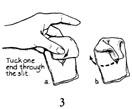Pie and Pastry Bible (139 page)
Read Pie and Pastry Bible Online
Authors: Rose Levy Beranbaum




Spread the apricot filling lengthwise evenly over half the dough. Starting from one long side, fold the dough in half so that the edges meet. You will now have a 16- by 5-inch rectangle of dough. Gently pat the dough so it adheres to the filling. With a pizza cutter or sharp knife, cut the dough crosswise into 2- by 5-inch rectangles. (Figure 1) Cut a 3-inch-long slit down the center of each rectangle. (There will be 1 inch of uncut dough at either end.) (Figure 2) Lift each rectangle, spread the slit to open it, and pull one uncut end of the pastry down through the slit and up and over to form a bow shape. (Figures 3 and 4) (For a double slip, repeat with the other end.) Place the slips at least 1½ inches apart on the prepared baking sheets.
If you have two 2-inch-deep 18-inch-long sheet pans, invert them over the dough (see page 488). Alternatively, cover the dough lightly with plastic wrap that has been sprayed with nonstick vegetable spray and set the sheet pans aside in a warm spot. Allow to rise for about 2 hours. The slips should almost double and be very light to the touch.
Preheat the oven to 400°F. at least 20 minutes before baking. Set an oven rack at the middle level before preheating.
Five minutes ahead of baking, place a pan with about 1 inch of boiling water in the lower part of the oven. (To prevent a ring from forming if using a metal pan, add a pinch of cream of tartar to the water.) Place the slips in the oven, lower the temperature to 375°F., and bake for 15 to 18 minutes or until golden brown (200° to 210°F.).
While the slips are baking, prepare the sugar glaze: In a small bowl, place the powdered sugar. Whisk in the water and lemon juice. The glaze should be the consistency of egg white. If necessary, add a little more sugar or water.
When the slips are done, remove the baking sheet to a rack and immediately brush the slips with the glaze. Cool for 5 to 10 minutes.
These are best eaten warm or within 3 hours of baking.
STORE
Room temperature, up to 2 days; frozen, up to 3 months. The baked Danish can be reheated in a preheated 300°F. oven for 5 minutes (8 minutes if frozen).
POINTERS FOR SUCCESS
 It is best to cover the dough with the inverted 2-inch-deep pans so that nothing touches the surface.
It is best to cover the dough with the inverted 2-inch-deep pans so that nothing touches the surface.
DANISH SNAIL BUNS
T
hese classic Danish pastries are spread with just enough almond filling to keep them moist, sprinkled with brandy-plumped raisins, walnuts, and cinnamon sugar, and finally rolled and cut to resemble snails.
| OVEN TEMPERATURE: 400°F., THEN 375°F. • BAKING TIME: 18 TO 20 MINUTES MAKES: TWENTY-FOUR 3¼- to 3° BY 1-INCH-HIGH BUNS | |||
|---|---|---|---|
| INGREDIENTS | MEASURE | WEIGHT | |
| | VOLUME | OUNCES | GRAMS |
| 1 recipe Danish Pastry Dough (page 486) | | 26.7 ounces | 762 grams |
| Filling Brandied Raisins (page 514) | ¼cup | 4.75 ounces | 135 grams |
| Remonce (page 510) |  cup cup | 6 ounces | 170 grams |
| Cinnamon Sugar and Walnut Sprinkle sugar | 1 tablespoon | approx. 0.5 ounce | 12.5 grams |
| ground cinnamon |  teaspoon teaspoon | • | • |
| toasted walnuts, chopped medium-fine | ¾cup | 2.6 ounces | 75 grams |
| Transparent Sugar Glaze powdered sugar | (2 tablespoons) ¼ cup | • 1 ounce | 30 grams |
| water | 1½ teaspoons | • | • |
| freshly squeezed lemon juice | 1 teaspoon | • | • |
EQUIPMENT
Two large baking sheets or half-size sheet pans, lined with parchment
*
Make the dough (see page 486).
Advance preparation:
The brandied raisins must be made at least 24 hours ahead.
SHAPE THE SNAILS
Remove the dough from the refrigerator and cut it in half. Work with half the dough at a time, refrigerating the other half. Allow the dough to sit for 15 minutes.
On a floured counter, roll it out to a rectangle about 10 inches by 12 inches. Slip it onto a baking sheet, cover it lightly, and refrigerate it for 30 minutes to relax the gluten.



